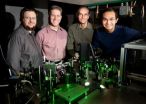(Press-News.org) As the eurozone continues to wobble, new analysis of countries' economic interconnectedness finds that some of the countries with the greatest potential to cause a global crash have surprisingly small gross domestic production.
Using data from Bureau Van Dijk - the company information and business intelligence provider - to assess the reach and size of different countries' economies, and applying the Susceptible-Infected-Recovered (SIR) model, physicists from universities in Greece, Switzerland and Israel have identified the twelve countries with greatest power to spread a crisis globally.
The research published today, Thursday 25 November 2010, in New Journal of Physics (co-owned by the Institute of Physics and German Physical Society), groups Belgium and Luxembourg alongside more obviously impactful economies such as the USA in the top twelve.
Using a statistical physics approach, the researchers from the Universities of Thessaloniki, Lausanne and Bar-Ilan used two different databases to model the effect of hypothetical economic crashes in different countries. The use of two different databases aided the avoidance of bias but threw up very similar results.
The data used allowed the physicists to identify links between the different countries, by mapping the global economy to a complex network, and gauge the likelihood of one failed economy having an effect on another.
One network was created using data on the 4000 world corporations with highest turnover and a second using data on import and export relations between 82 countries.
The SIR model, successfully used previously to model the spreading of disease epidemics, is applied to these two networks taking into consideration the strength of links between countries, the size of the crash, and the economic strength of the country in potential danger.
When put to the test with the corporate data, the USA, the UK, France, Germany, Netherlands, Japan, Sweden, Italy, Switzerland, Spain, Belgium and Luxembourg were part of an inner core of countries that would individually cause the most economic damage globally if their economies were to fail.
Using the import/export data, China, Russia, Japan, Spain, UK, Netherlands, Italy, Germany, Belgium, Luxembourg, USA, and France formed the inner core, with the researchers explaining that the difference – particularly the addition of China to this second list – is due to a large fraction of Chinese trade volume coming from subsidiaries of western corporations based in China.
The researchers write, "Surprisingly, not all 12 countries have the largest total weights or the largest GDP. Nevertheless, our results suggest that they do play an important role in the global economic network. This is explained by the fact that these smaller countries do not support only their local economy, but they are a haven for foreign investments."
###
The researchers' paper can be downloaded for free from Thursday 25 November 2010 here: http://iopscience.iop.org/1367-2630/12/11/113043/fulltext
END
Fifty-seven laboratories from 29 countries volunteered to put their measuring competence to the test. Each laboratory received a sample without knowing the levels of heavy metals present, and was asked to measure and report the values back to the JRC.
The good results should enhance consumers' confidence, as maximum levels of lead, cadmium and total mercury in seafood are regulated by EU law and it has been proven that most participants are able to correctly measure them. In addition, this comparison has highlighted other issues, such as the apparent dependency of the ...
About 30% of breast cancer patients have tumours that show rapid growth and invasion through the body. A common denominator in all of these cases is the presence of a large number of Her2 proteins in tumour cellular membranes. Consequently, these aggressive tumours are referred to as HER2+. Scientists working in the Metastasis Laboratory (MetLab) at IRB Barcelona headed by ICREA researcher Roger Gomis, have described the molecular mechanism that induces HER2+ tumours to ignore the signals that protect cells from excessive growth. The study is published this week in the ...
In the wake of devastating cholera outbreaks in refugee camps in earthquake-wracked Haiti, a group of leading experts from Harvard Medical School, George Washington University, and the International Vaccine Institute (IVI) have urged the United States to create an emergency stockpile of cholera vaccines for future humanitarian use.
"The costs to the U.S. of creating and maintaining a stockpile of several million doses of cholera vaccine would be low," said the experts in an article published online first on November 24 in The New England Journal of Medicine (NEJM). "But ...
A new process for creating a personalized vaccine may become a crucial tool in helping patients with colorectal cancer develop an immune response against their own tumors. This dendritic cell (DC) vaccine, developed at Dartmouth and described in a research paper published this week in the journal Clinical Cancer Research, was used after surgical resection of metastatic tumors to try to prevent the growth of additional metastases.
"The results of the study suggest a new way to approach cancer treatment," said Richard Barth Jr., MD, Chief of General Surgery at Dartmouth-Hitchcock ...
The search is on for insects, mites, microbes or nematodes that could be used in a biologically based approach to controlling silverleaf nightshade, an invasive weed from the Americas that has spread to southern Europe, Africa, India, Australia and elsewhere.
According to U.S. Department of Agriculture (USDA) entomologist Walker Jones, the perennial weed, Solanum elaeagnifolium, is being targeted for its ability to outcompete native plants, reduce crop yields and diminish pasture productivity. Its orange, toxin-producing berries can also poison livestock.
Severe infestations ...
London, UK, 24 November 2010 – Research from the Laboratory of Psychiatry and Experimental Alzheimers Research (http://www2.i-med.ac.at/psychlab/) at the Medical University Innsbruck (Austria) demonstrated that chronic high fat cholesterol diet in rats exhibited pathologies similar to Alzheimer's disease. The results were published in Molecular Cellular Neuroscience (45(4):408-417, 2010) with lead author Dr. Christian Humpel. The study was co-authored by PhD students, Celine Ullrich and Michael Pirchl, from the same Laboratory.
Alzheimer's disease is a severe neurodegenerative ...
Mildew infections not only cause unsightly vegetable patches, they can also result in extensive crop failure. Interestingly, the processes involved in infections with this garden pest are similar to those involved in fertilisation. Scientists from the Max Planck Institute for Plant Breeding Research in Cologne and the University of Zurich have identified two proteins in the model plant species Arabidopsis thaliana that are necessary for both fertilisation and infection with powdery mildew. This explains why mildew-resistant plants, in which these genes are mutated, are ...
Leading experts from the European Society on Clinical and Economic Aspects of Osteoporosis and Osteoarthritis (ESCEO) and the International Osteoporosis Foundation (IOF) have published a timely position paper on the association between subtrochanteric femoral (upper thigh bone) fractures and long-term treatment with bisphosphonates.
Bisphosphonates are the most common drug therapy for osteoporotic fracture prevention, prescribed to millions of people around the world. Concern among doctors and patients has arisen following recent media reports that cite a possible association ...
CAMBRIDGE, Mass. -- In a new study to be published in the Nov. 25 issue of Nature, MIT cancer biologists show that restoring the protein p53's function in mice with lung cancer has no effect early in tumor development, but restoring the function later on could prevent more advanced tumors from spreading throughout the body.
Cancer researchers have known since the 1980s that p53 plays a critical role in protecting cells from becoming cancerous. P53 is defective in about half of all human cancers; when it functions correctly, it appears to suppress tumor formation by preventing ...
CHAMPAIGN, Ill. – The long, anxious wait for biopsy results could soon be over, thanks to a tissue-imaging technique developed at the University of Illinois.
The research team demonstrated the novel microscopy technique, called nonlinear interferometric vibrational imaging (NIVI), on rat breast-cancer cells and tissues. It produced easy-to-read, color-coded images of tissue, outlining clear tumor boundaries, with more than 99 percent confidence – in less than five minutes.
Led by professor and physician Stephen A. Boppart, who holds appointments in electrical and computer ...

